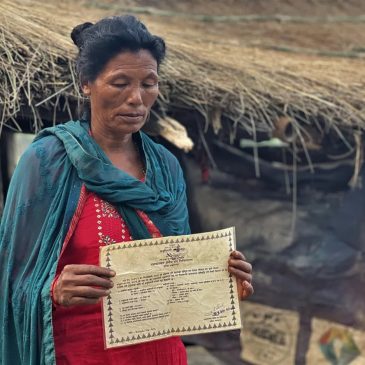This summary report aims to analyze the human rights challenges of Nepal’s endangered Indigenous Bankariya people, particularly to their lands and forest resources, due to Parsa National Park in the south of the country. Traditionally a nomadic group living in forests, Bankariyas were provided six hectares of leasehold forests, where they currently live in informal settlements. The leasehold forests were later incorporated in the buffer zone of the Parsa National Park. Almost two decades later, Bankariyas now face the same challenge as around 6 million people of 34 districts living in buffer zones of various protected areas of Nepal. They do not have titles to the lands that they have been living on, using or occupying for generations. As a result, they face threats of forced evictions and displacement from their current settlement upon expiry of their lease and in lack of land titles.
The threats are growing these days with the end of the lease period approaching while the Parsa National Park increasingly assert its authority over the lands that the Bankariya have traditionally occupied and used in the buffer zone of the Park. Accordingly, Bankariyas have been demanding land titles for the lands they have lived on, used and occupied.
Registration of the lands of Bankariyas however have been continuously shelved despite pledges from the elected representatives and provincial government authorities, and formation of a number of successive commissions to resolve issues of landlessness in Nepal. In lack of land titles, Bankariyas have not been able to receive government support for farmers such as insurance for agricultural produce or grants, including for animal husbandry. Bankariya youth also lamented that they cannot access bank loans in lack of land titles to use as collateral.
At the same time, Bankariyas have faced problems from the forest authorities, who have frequently attempted to evict them from their settlement. Surrounded by two rivers, Bankariyas encounter difficulties traveling during the rainy season and selling the vegetables that they grow as flooding in the rivers sometimes even threatens to sweep away their settlement. Bankariya children also have challenges to access education due to the long distance to the nearest school.
Besides land titles, during the research, Bankariyas have demanded that they be provided access to the forest resources in the Parsa National Park as they depend on those resources for their living, traditions and identity. For example, they traditionally consume wild yams and use broom corn as well as other wild vegetables and herbs from the forests that are also important for their customs and rituals. However, they cannot access those forest resources with the limited rights provided to them in the community forest in the buffer zone. As a result, they have even faced challenges with the Park authorities and continue to live in constant fear to access forest products. For example, in Magh of 2079 BS (January 2023), 5 women and two Bankariya men were detained for a night at the Park office in Aadhabhar when they went to cut broom corn.
Parsa National Park is directly and indirectly supported by various international agencies, including the World Wide Fund for Nature (WWF, formerly World Wildlife Fund), the International Union for Conservation of Nature (IUCN), the German Development Bank (KfW), and the Zoological Society of London (ZSL), among others. The Park has been included in the Terai Arc Landscape (TAL) programe recognized and honored by the UN Environment Programme (UNEP) and the Food and Agriculture Organization of the UN (FAO). It has accordingly contributed to Nepal claim result-based payment through REDD+ and has also been part of REDD+ programme under the Forest Carbon Partnership Facility (FCPF) of the World Bank.
Even though international human rights obligations of Nepal require the authorities to address the land and resource rights of the Bankariyas affected by the Parsa National Park and , the national laws and processes provide limited opportunities, but serious challenges remain for them with the legal and other complexities. While continuing to push for their rights within the national framework, Bankariyas need to exercise leverage with the international agencies supporting the Park as well as international human rights mechanisms to assert their rights. Thus, the report puts forth a list of recommendations to the concerned national authorities and international agencies to protect and promote the land and resource rights of the Indigenous Bankariya community.
Click here to read the full report.
